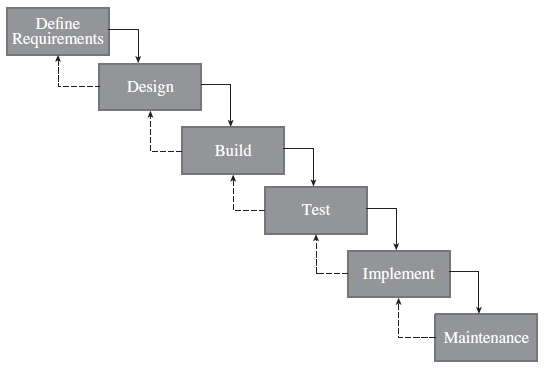Waterfal Method in Implementing System Development Life Cycle (SDLC)

System Development Life Cycle or SDLC is a framework that are used to defining tasks that will be performed at each step in the software development process. SDLC is a structure followed by a development team within the software organization. The Software Development Process consists of: :
1. Planning
2. Analysis
3. Design
4. Implementation
5. Maintenance and Support.
There are a 2 ways (best practices) to implementing the SDLC there are Waterfal Approach and Agile Approach.
Waterfall Approach
Waterfall approach was first SDLC Model to be used widely in Software Engineering to ensure success of the project. In “The Waterfall” approach, the whole process of software development is divided into separate phases. These phases are arranged from the conceptual to technical. In Waterfall model, typically, the outcome of one phase acts as the input for the next phase sequentially.

Phases :
- Requirement Gathering and analysis: All possible requirements of the system to be developed are captured in this phase and documented in a requirement specification doc.
- System Design: The requirement specifications from first phase are studied in this phase and system design is prepared. (The output of the previous step become the input of the next step). System Design is going to specify the hardware and the system requirements and also helps in defining overall system architecture (1 tier, 2 tire or n tire).
- Implementation: With inputs from system design, the system is first developed in small programs called units, which are integrated in the next phase. Each unit is developed and tested for its functionality which is referred to as Unit Testing.
- Integration and Testing: All the units developed in the implementation phase are integrated into a system after testing of each unit. Post integration the entire system is tested for any faults and failures.
- Deployment of system: Once the functional and non functional testing is done, the product is deployed in the customer environment or released into the market.
- Maintenance: There are some issues which come up in the client environment. To fix those issues patches are released. Also to enhance the product some better versions are released. Maintenance is done to deliver these changes in the customer environment.
All these phases are flowing to each other in which progress is seen as flowing steadily downwards (like a waterfall) through the phases. The next phase is started only after the the output of the previouse steps has been fulfilled.
The Situation where the use of Waterfal method is most appropriate are :
- Requirements are very well documented, clear and fixed.
- Product definition is stable.
- Technology is understood and is not dynamic.
- There are no ambiguous requirements.
- Ample resources with required expertise are available to support the product.
- The project is short.
The Pros and Conts of Waterfal Approach :
- Pros
It allows for departmentalization and control.
2. A schedule can be set with deadlines for each stage.
3. Development moves in Order
- Cons
It does not allow for much reflection or revision.
2. Once an application is in the testing stage, it is very difficult to go back and change something.
3. High amounts of risk and uncertainty.

